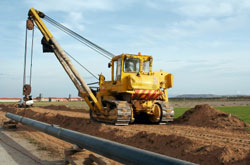
Lesson Extension 2
Energy Underground – It’s Down to Earth
 Natural gas is often found at sites with deposits of petroleum materials and is brought to the surface with the oil. Some wells yield only natural gas. Drills used to find gas can be cork-screw shaped or may be a “punch” type for drilling in softer rock. Offshore drilling platforms not only contain specialized equipment, but must be fitted with comfortable living quarters for crews. These platforms may be two types: floating or fixed to the sea floor.
Natural gas is often found at sites with deposits of petroleum materials and is brought to the surface with the oil. Some wells yield only natural gas. Drills used to find gas can be cork-screw shaped or may be a “punch” type for drilling in softer rock. Offshore drilling platforms not only contain specialized equipment, but must be fitted with comfortable living quarters for crews. These platforms may be two types: floating or fixed to the sea floor.
Natural gas straight from the drilling site is not always the pure form: dirt, water and sulfur are removed. Several valuable elements contained in the gas are removed as the refining process begins. Butane, propane and ethane are extracted for other purposes, leaving the main ingredient, methane. Methane, a hydrocarbon, is the colorless and odorless gas we call “natural gas.”

Methane’s low flammability factor make it an ideal fuel for transport. It should never be allowed to build up in an enclosed space though; it could become explosive. For safety reasons, a peculiar smell is added to the gas as it leaves the point of distribution. The distinctive smell of rotten eggs is the trademark of the chemical additive, mercaptan. Adding mercaptan makes it easier to detect leaks. Tell your students that if they smell rotten eggs, they should alert others nearby and leave the area. Report from another location by telephone to the gas company; do not use a phone or cell phone in the building where the gas leak is suspected. Do not turn on OR off any lights or electric appliances.
Natural gas is a safe, versatile resource that provides energy for thousands of industries and millions of homes and businesses. Check out other Energy Underground sections for additional information about natural gas, nature’s energy resource.
“To the Moon, Alice”
 A popular TV show in the 1950s featured a family breadwinner who, when displeased with his wife Alice’s actions, would facetiously offer her a one-way ticket to the moon each week. Knowing that a one-way trip to the moon logs 239,000 miles (thanks to Neil Armstrong, 1969), Alice would have quite a trip.
A popular TV show in the 1950s featured a family breadwinner who, when displeased with his wife Alice’s actions, would facetiously offer her a one-way ticket to the moon each week. Knowing that a one-way trip to the moon logs 239,000 miles (thanks to Neil Armstrong, 1969), Alice would have quite a trip.
By comparison, there are as many natural gas pipelines in just our country that if they were stretched into outer space, they would make that trip to the moon and back, two whole times. The underground gas pipeline network runs for 1.3 million miles, according to statistics from the American Gas Association.
Natural gas travels at the rate of about 15 miles per hour through elaborate pipeline systems to consumers all over the United States. Sophisticated pumping station systems at strategic points take out gas product then pump the rest on to other locations. Interesting math lessons might evolve from calculating how long it would take for natural gas to leave a pumping station in Savannah, Georgia, to travel to Portland, Oregon.

Gas is a versatile fuel that can be stored in underground reservoirs, in pipes and in tanks. It can be converted easily to a pressurized form known as liquid propane gas (LPG) and made available to those living far from pipelines. Underground pipes deliver natural gas to building foundations for consumption. From there, gas is sent through a metering device and delivered through tap-offs to any gas appliance. The meter is read periodically in order to bill consumers.
The industry of natural gas is very efficient, more than 90% of the gas is conveyed as a useful energy resource, as opposed to other forms of energy. Natural gas produces an instant and reliable energy source that the world uses in an infinite number of ways: from making glass to cooking food to heating homes, from steel-making to brick baking, and from hardening machinery gears to making paper and cloth.
Whether in the production end of natural gas at the well or involved in the manufacture of it, whether in designing pipeline systems or in the operation of efficient points of distribution, the 170,000 people employed in the gas industry work hard to make sure that supplies keep up with consumer demands in the safest, most cost-effective ways.
